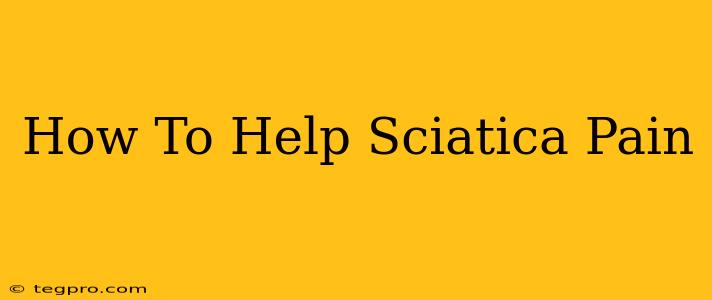Sciatica, that sharp, shooting pain radiating down your leg, can be debilitating. But understanding its causes and employing effective strategies can significantly alleviate your suffering. This comprehensive guide explores various ways to help sciatica pain, empowering you to regain control over your well-being.
Understanding Sciatica: What Causes This Nerve Pain?
Sciatica isn't a disease itself, but rather a symptom. It arises from irritation or compression of the sciatic nerve, the longest nerve in your body, which runs from your lower back down through your hips and buttocks into your legs. Several factors can contribute to this compression:
- Herniated Disc: A bulging or ruptured disc in your spine can press on the sciatic nerve.
- Spinal Stenosis: Narrowing of the spinal canal puts pressure on the nerve roots.
- Spondylolisthesis: This is when one vertebra slips forward over another, potentially irritating the nerve.
- Piriformis Syndrome: This involves the piriformis muscle, located in your buttock, compressing the sciatic nerve.
- Pregnancy: Hormonal changes and the added weight during pregnancy can contribute to sciatica.
Effective Ways to Help Sciatica Pain at Home
Before considering more invasive treatments, numerous at-home strategies can provide significant relief:
1. Gentle Movement and Exercise
While intense activity might exacerbate pain, gentle movement is crucial. Consider these options:
- Walking: Low-impact walking helps improve circulation and can ease pain.
- Yoga: Specific yoga poses can stretch and strengthen muscles supporting the spine, improving nerve function. Look for classes focusing on back health.
- Swimming: The buoyancy of water supports your body, reducing stress on your spine.
- Cycling: Stationary cycling is a low-impact exercise that can improve flexibility and strength.
Important Note: Always consult your doctor or physical therapist before starting any new exercise program. Start slowly and gradually increase intensity as tolerated.
2. Over-the-Counter Pain Relief
Non-steroidal anti-inflammatory drugs (NSAIDs) like ibuprofen or naproxen can help reduce inflammation and pain. Always follow dosage instructions carefully. Consider using a topical cream containing capsaicin for localized pain relief.
3. Heat and Ice Therapy
Both heat and ice can be effective, depending on the stage of your sciatica.
- Heat: Applying a heating pad or warm compress can relax muscles and ease pain.
- Ice: Ice packs can reduce inflammation and numb the area. Apply ice for 15-20 minutes at a time.
Experiment to find what works best for you. Some find alternating heat and ice to be most effective.
4. Lifestyle Modifications
Certain lifestyle changes can significantly impact your sciatica:
- Maintain a Healthy Weight: Excess weight puts extra strain on your spine.
- Proper Posture: Maintaining good posture while sitting, standing, and lifting can prevent further strain.
- Ergonomic Setup: Ensure your workstation is ergonomically sound to minimize strain.
When to Seek Professional Medical Help
While home remedies can offer relief, it's crucial to seek professional medical attention if:
- Your pain is severe or doesn't improve with home treatment.
- You experience bowel or bladder dysfunction.
- You have weakness or numbness in your leg or foot.
- You experience pain that radiates below the knee.
A healthcare professional can diagnose the underlying cause of your sciatica and recommend appropriate treatment, which may include physical therapy, medication, or in rare cases, surgery.
Conclusion: Managing Sciatica for Long-Term Relief
Sciatica can be a challenging condition, but by understanding its causes and employing a combination of self-care strategies and professional guidance, you can effectively manage your pain and improve your quality of life. Remember that consistency is key; stick to your treatment plan, and don't hesitate to reach out for help when needed. With the right approach, you can find relief and return to a more active and pain-free life.

